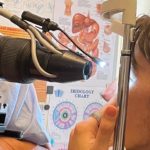Different Types Of Diabetes And How To Treat Them
Diabetes is a long-lasting chronic disease that affects how your body turns food into energy. The number of people diagnosed with Diabetes in the UK has more than doubled in the last 20 years. It is also on the increase worldwide especially in USA, Europe, Africa and Asia. Obesity and consuming more processed foods that are high is sugar and other preservatives is a major contributing factor. Diabetes is a major cause of blindness, heart attacks, strokes, kidney failure and amputations.
The early signs of Diabetes include frequent urination and increased thirst. When your blood sugar is high, your kidneys expel the excess blood sugar and this causes you to urinate more frequently. When you urinate frequently, valuable fluids are removed from your tissues and this will cause you to feel thirsty so that you replenish the liquids that has been expelled.
There are various types of Diabetes. The most commonly known ones are Diabetes Type 1 and Diabetes Type 2. Taking certain medications such as steroids and antipsychotics could lead to other types of Diabetes as well as hormonal imbalances and surgery. Patients with schizophrenia are more likely to develop Diabetes. They are also more likely to die from cardiovascular disease as a result of reliance on these medical drugs.
Type 1 Diabetes is a serious condition where your blood sugar or glucose level is too high because your body cannot make a hormone called insulin. This happens when your body attacks the cells in your pancreas that make the insulin. This means you cannot produce any insulin. Insulin allows the glucose in our blood to enter our cells and fuel our bodies. We therefore need insulin to live.
Diabetes Mellitus is not an auto immune condition where the body has destroyed the insulin producing cells. It is also known as Type 2 Diabetes. Obesity and an inactive lifestyle are the two main causes. It normally starts around middle and late adulthood. However, due to a more sedentary lifestyle, more children and teenagers are developing this condition.
Type 3 Diabetes is not a recognised medical condition. It happens when the pancreas stops producing enough insulin for the body. Your pancreas also stops producing the enzyme that you need to digest food. It is linked to other conditions linked to the pancreas such as pancreatitis, cystic fibrosis and pancreatic cancer.
Maturity Onset Diabetes of the Young (MODY) is a rare form of Diabetes and runs strongly in families. It is caused by a change or mutation in a single gene. Children have 50% chance of inheriting this gene from their parents. When this happens, the child will normally inherit MODY before the age of 25. You should get yourself checked if this rare form of Diabetes runs in your family.
Neonatal Diabetes is normally diagnosed under the age of 6 months. It is not an autoimmune condition where the body has destroyed its insulin producing cells. This type of Diabetes is very rare. Transient Neonatal Diabetes does not last forever and usually resolves before the age of 12 months. It usually recurs during teenage years.
Steroid-Induced Diabetes is caused by taking artificial versions of hormones that are naturally produced by your body. High doses of steroids that are taken either orally or via an injection are more likely to affect your blood sugar levels. This type of Diabetes can stop when you stop taking steroids. However, if you already have Type 2 Diabetes, this can continue even after you have stopped taking steroids.
Cystic Fibrosis Diabetes is a type of Diabetes most common in people with Cystic Fibrosis. This is a genetic condition that some people are born with, caused by both parents passing on a faulty CFTR gene. Symptoms include breathing problems, problems with digestion and lung infections. This is caused by the build up of thick and sticky mucus that builds up in the lungs, pancreas and other organs. This mucus can lead to inflammation and scarring of the pancreas.
Over time, high blood sugar levels that are not managed will damage your eyes, heart, kidneys and feet. It is therefore important that you are aware how to prevent diabetes or treat it. You can prevent or treat Diabetes by managing your food and drinks intake. Abstain from processed foods and drinks that are high in sugar, especially white sugar. Processed foods that are more harmful with little or no nutrition includes donuts, white bread, cookies, cakes and pizza. Contrary to popular belief, some foods that do not taste sweet are also bad for you. A great example is white rice. Tests have proven that there is more sugar in white rice than very sweet tasting glucose. This is why Diabetes is on the increase in countries where white rice is the main staple food. Soda and sugary fizzy drinks are also harmful, more so the “diet” versions as these contain artificial sweeteners.
There are some foods that you can eat a lot more of to manage or revese your Diabetes. These include most fresh fruits, vegetables and herbs. Have you tried bittergourd, bitter melon or karela? As per the name, this tastes bitter, however is good for Diabetes and most other diseases. Do try it as a few moments of unpleasant taste will give you many hours of health.
Maintaining a healthy weight and lifestyle is also crucial. Ensure you do some light or moderate exercise daily be it some household chores, walking a bit more or climbing stairs instead of taking the lift or escalator. Enrolling in exercise classes or hiring a personal trainer may take the boredom out of exercising and improve accountability in keeping your actions consistent.
Do download our free Best Ways To Treat Diabetes Guide and also check out our 2 Diabetes courses for more guidance on how to deal with Diabetes or prevent it.
Check out our other blogs on Diabetes.
Can Iridology Detect Diabetes?
Diabetes Treatment Using Olive Oil
How To Use Iridology To Spot Diabetes
What You Need To Know About Diabetes
NEXT STEPS
Book in a complimentary 15 minutes Zoom call with us (valued at £99) to enable us to clarify questions you may have on a specific health concern.




